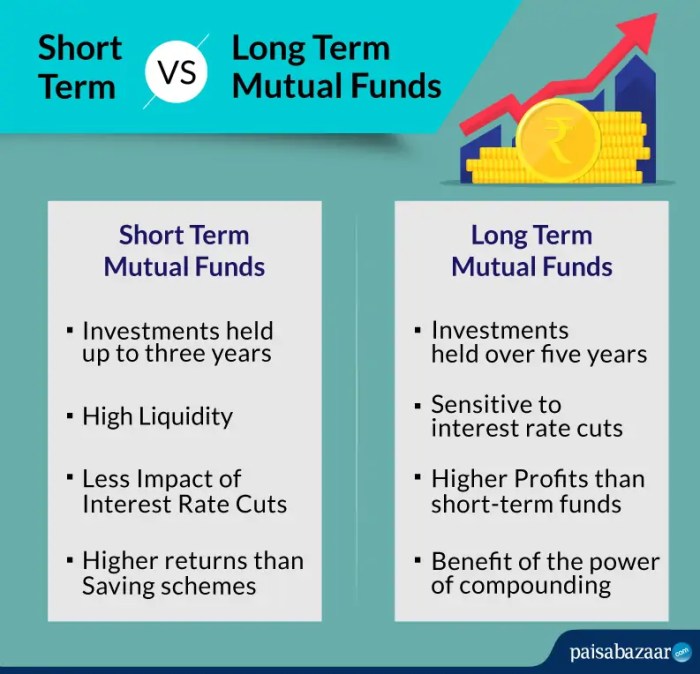With Short-term vs long-term investments at the forefront, this paragraph opens a window to an amazing start and intrigue, inviting readers to embark on a storytelling journey filled with unexpected twists and insights.
Understanding the difference between short-term and long-term investments is crucial for making informed financial decisions. Short-term investments offer quick returns but come with higher risks, while long-term investments can provide stability and growth over time. Let’s delve deeper into the world of investing to see which strategy aligns best with your financial goals.
Short-term vs Long-term Investments
Short-term investments are financial instruments designed to be held for a short period, typically less than a year, with the goal of generating quick returns. On the other hand, long-term investments are assets held for an extended period, usually more than a year, with the aim of building wealth over time.
Short-term Investment Vehicles
Short-term investment options include:
- Savings accounts
- Certificates of Deposit (CDs)
- Treasury bills
- Money market accounts
- Short-term bonds
Long-term Investment Options
Long-term investment vehicles consist of:
- Stocks
- Mutual funds
- Real estate
- Retirement accounts (401(k), IRA)
- Government and corporate bonds
Benefits and Risks of Short-term vs Long-term Investments
Short-term investments offer liquidity and quick access to cash, making them suitable for emergency funds or short-term financial goals. However, they usually yield lower returns compared to long-term investments. On the other hand, long-term investments have the potential for higher returns due to compounding over time but come with higher risk exposure to market fluctuations. Additionally, long-term investments require patience and discipline to ride out market volatility for potential growth.
Factors Influencing Investment Decisions
When it comes to making investment decisions, there are various factors that can influence an individual’s choice between short-term and long-term investments. These factors can range from personal financial goals to risk tolerance levels.
Factors for Short-term Investments
Short-term investments are often chosen by individuals who have immediate financial needs or goals that require quick access to funds. Some factors that influence people to opt for short-term investments include:
- The need for liquidity in case of emergencies or unforeseen expenses.
- The desire to take advantage of short-term market fluctuations or opportunities.
- The intention to fund short-term goals such as a vacation, home renovation, or purchasing a car.
Factors for Long-term Investments
On the other hand, long-term investments are typically chosen by individuals who are looking to build wealth over time and achieve financial stability in the future. Factors that drive people towards long-term investment strategies include:
- The goal of saving for retirement or a child’s education, which requires consistent growth over an extended period.
- The potential for higher returns and compounding interest over the long term.
- The ability to ride out market volatility and benefit from long-term economic growth.
Impact of Financial Goals
One of the most significant factors that influence the choice between short-term and long-term investments is an individual’s financial goals. Those with short-term financial goals may prioritize immediate access to funds and lower risk investments, while individuals with long-term financial goals may focus on building wealth over time and are willing to take on more risk for potentially higher returns.
Role of Risk Tolerance
Risk tolerance plays a crucial role in deciding between short-term and long-term investments. Those with a lower risk tolerance may prefer short-term investments that offer more stability and predictability, even if the returns are lower. On the other hand, individuals with a higher risk tolerance may be more inclined towards long-term investments that have the potential for greater returns, despite the higher level of volatility in the market.
Investment Strategies for Short-term and Long-term Goals

When it comes to achieving financial goals, having a well-thought-out investment strategy is crucial. Whether you are aiming for short-term gains or long-term wealth accumulation, the way you approach your investments can significantly impact your success in reaching your objectives.
Short-term Investment Strategies
Short-term financial goals typically involve saving for a specific purchase or covering emergency expenses. To achieve these goals, individuals often opt for investment strategies that focus on preserving capital while generating modest returns. Some common short-term investment strategies include:
- High-yield savings accounts: These accounts offer higher interest rates compared to traditional savings accounts, providing a safe and easily accessible option for short-term cash needs.
- Certificates of deposit (CDs): CDs lock in your money for a specific period at a fixed interest rate, making them suitable for short-term goals with a predetermined timeline.
- Money market funds: These funds invest in low-risk securities and provide liquidity, making them a popular choice for short-term investments.
Long-term Investment Strategies
Long-term wealth accumulation requires a different approach, focusing on building a diversified portfolio that can withstand market fluctuations and generate substantial returns over time. Some key long-term investment strategies include:
- Stock market investments: Investing in a diversified portfolio of stocks can offer long-term growth potential, although it comes with higher volatility compared to other investment options.
- Real estate investments: Real estate can be a valuable long-term investment, providing rental income and potential appreciation in property value over time.
- Retirement accounts: Contributing to retirement accounts like 401(k)s or IRAs can help individuals build a nest egg for their future, with tax advantages that promote long-term savings.
Comparison of Investment Vehicles
When considering short-term versus long-term objectives, the choice of investment vehicles plays a crucial role in determining the success of your investment strategy. Short-term investments focus on liquidity and capital preservation, while long-term investments prioritize growth and wealth accumulation. It’s essential to select investment vehicles that align with your specific financial goals and time horizon.
Role of Diversification
Diversification is a key principle that applies to both short-term and long-term investment portfolios. By spreading your investments across different asset classes, industries, and regions, you can reduce risk and enhance the overall stability of your portfolio. Diversification helps mitigate the impact of market volatility and provides a more balanced approach to achieving your financial goals.
Market Volatility and Short-term vs Long-term Investments

Market volatility plays a significant role in influencing investment decisions, whether short-term or long-term. Understanding how market fluctuations impact investments is crucial for investors to develop effective strategies to mitigate risks and maximize returns.
Impact of Market Volatility on Short-term Investments, Short-term vs long-term investments
Market volatility can have a profound impact on short-term investment decisions. Sudden price fluctuations can lead to significant gains or losses in a short period, making short-term investments more risky compared to long-term investments. Investors in short-term positions may need to closely monitor market trends and be prepared to act quickly to capitalize on opportunities or protect their investments.
Impact of Market Volatility on Long-term Investment Returns
While market volatility can be unsettling for long-term investors, it is essential to understand that short-term fluctuations often have minimal impact on long-term investment returns. Long-term investors who stay committed to their investment strategies and resist the temptation to make impulsive decisions during market downturns are more likely to achieve their financial goals over time. In fact, market volatility can present buying opportunities for long-term investors to acquire assets at lower prices and potentially benefit from future growth.
Strategies to Mitigate Risks in Short-term Investments
To mitigate risks associated with market volatility in short-term investments, diversification is key. By spreading investments across different asset classes, industries, and geographical regions, investors can reduce their exposure to the impact of market fluctuations on any single investment. Setting stop-loss orders and having a clear exit strategy in place can also help protect investments from sudden downturns in the market.
Staying Resilient During Market Fluctuations for Long-term Investments
For long-term investors, staying resilient during market fluctuations involves maintaining a long-term perspective and not getting swayed by short-term market noise. Regularly reviewing and rebalancing investment portfolios to align with long-term financial goals, rather than reacting to short-term market movements, is essential. Additionally, focusing on fundamental analysis and the underlying value of investments can help long-term investors weather market volatility and stay on track towards achieving their objectives.
In conclusion, whether you opt for short-term gains or long-term growth, it’s essential to consider your financial objectives, risk tolerance, and market conditions. By understanding the nuances of each investment type, you can make well-informed decisions that pave the way for a secure financial future.
Obtain direct knowledge about the efficiency of Best investment strategies for 2025 through case studies.


